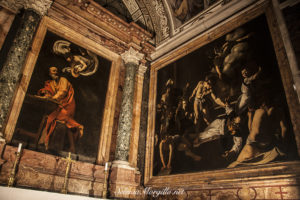Caravaggio in Rome: the Contarelli Chapel
(Italian Version below*)
“Going away, Jesus saw a man sitting at the tax office, called Matthew and said follow me … and he got up and followed him …. “
Caravaggio’s fame in Rome was definitively established following the first great public work.
On July 23, 1599, Father Berlinghiero of the Reverend “Fabbrica di San Pietro” commissioned him the side paintings of the Contarelli Chapel in San Luigi dei Francesi (St. Loius of the French) not far from Piazza Navona.
Caravaggio carried out the Martyrdom of Matthew and the Vocation of Matthew and the work was welded on July 4th, 1600.
The Martyrdom of Matthew visible on the right side of the Chapel was the first to be performed and the numerous travails of the artist have come back to light since 1951 when the ICR (Istituto Superiore per la Conservazione ed il Restauro), following a radiographic campaign, showed the different regrets. (HERE)
The scene of the Martyrdom of Matthew is set up by pivoting on the executioner of the Saint in the act that precedes the final blow.
From this figure, all the other figures branch out: from the angel holding out the palm of Martyrdom, to the little boy in the act of shouting, to the man in profile (bottom left side) in which the critics wanted to see the self-portrait of the “master”. (Focus Self-portrait)
After the Martyrdom, Caravaggio created the canvas of the Vocation placed on the left side, among his greatest masterpieces.
The event is set in a bare Roman tavern of which the artist was a frequent visitor. Christ and Peter (first characters on the right side) enter the room of Matteo the tax collector, where a transaction is in progress and five men are seated around a table.
The taxpayer Matteo and his page are recognized in which the critics see Mario Minniti as a model, Caravaggio’s friend.
The hand of Christ stretches towards Matthew, underlined by the only beam of light that illuminates the tavern, is a clear quote fro Michelangelo Creation of Adam in the vault of the Sistine Chapel.
To the first two paintings, in 1602 Caravaggio also added the altarpiece with the subject of San Matteo and the Angel.
The first version, considered too naturalistic, with a Saint Matthew in the foreground with his knees crossed and the angel who took his hand taught him to write, was refused and was destroyed during the Second World War.
The second version, which can be appreciated today on the altar of the Chapel, features an elderly and wise Saint and the angel, both placed along a mezzanine at the base of the composition. The trick of the stool poised crosswise to accentuate the volumes is excellent.
Are you curious to see the first version of San Matteo and the Angel .... Click here!!
Info Site: San Luigi dei Francesi is near Piazza Navona and not far from the Church of Sant’Agostino where another work by Caravaggio is visible: Pilgrim’s Madonna or La Madonna dei Pellegrini.
——————————————————————————————————————–
“Andando via di là, Gesù vide un uomo seduto al banco delle imposte, chiamato Matteo e gli disse seguimi… ed egli si alzò e lo seguì….”
La fama di Caravaggio a Roma si affermò, definitivamente, in seguito al primo grande lavoro pubblico. Il 23 Luglio 1599 Padre Berlinghiero della Reverenda Fabbrica di San Pietro gli commissionò i dipinti laterali della Cappella Contarelli in San Luigi dei Francesi.
Caravaggio realizzò il Martirio di Matteo e la Vocazione di Matteo ed il lavoro fu saldato il 4 Luglio 1600.
Il Martirio di Matteo visibile sul lato destro della Cappella fu il primo ad essere eseguito ed i numerosi travagli dell’artista sono ritornati in luce dal 1951 quando l’ICR, a seguito di una campagna radiografica, ha mostrato i diversi pentimenti. (QUI)
La scena è impostata facendo perno sul carnefice del Santo nell’atto che precede il colpo finale. Da questa figura si diramano tutte le altre figure: dall’angelo che porge la palma del Martirio, al ragazzino nell’atto di gridare, all’uomo posto di profilo (fondo lato sx) in cui la critica ha voluto vedere l’autoritratto del “maestro”. (Focus Autoritratto)
Dopo il Martirio, Caravaggio realizza la tela della Vocazione posta sul lato sinistro, tra i suoi massimi capolavori. L’evento è ambientato in una spoglia taverna romana di cui l’artista era un assiduo frequentatore.
Cristo e Pietro (primi personaggi sul lato destro) entrano nella stanza di Matteo il gabelliere, dove è in corso una transazione e 5 uomini sono seduti intorno ad un tavolo. Si riconoscono il contribuente Matteo ed il suo paggio in cui la critica vede come modello Mario Minniti, amico di Caravaggio.
La mano di Cristo tende verso Matteo, sottolineata dall’unico fascio di luce che illumina la taverna, è una chiara citazione della Creazione di Adamo di Michelangelo nella volta della Cappella Sistina.
Alle prime due tele, nel 1602 Caravaggio aggiunse anche la pala d’altare con il soggetto di San Matteo e l’Angelo.
La prima versione, considerata troppo naturalistica, con un San Matteo in primo piano con le ginocchia accavallate e l’angelo che prendendogli la mano gli insegnava a scrivere, fu rifiutata ed è andata distrutta durante la seconda guerra mondiale.
La seconda versione, apprezzabile oggi sull’altare della Cappella, presenta un Santo oramai anziano e saggio e l’angelo, entrambi collocati lungo un piano rialzato alla base della composizione. Eccellente l’escamotage dello sgabello posto in bilico di traverso per accentuare i volumi.
Sei curioso di vedere la prima versione di San Matteo e l’Angelo.... Clicca Qui!!
Info Site: San Luigi dei Francesi è nei pressi di Piazza Navona ed a poca distanza dalla Chiesa di Sant’Agostino in cui è visibile un’altra opera di Caravaggio: La Madonna dei Pellegrini.
Sostieni la #culturachevince, aiuta la condivisione.
